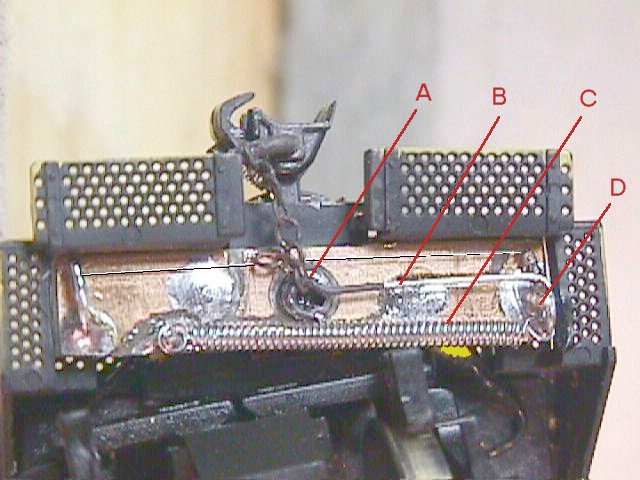DCC Controlled Coupler Actuator
Coupler in actuated position
The actuator arm is a "T" shape with a small hook formed at the bottom
of the "T". (Fig. 5-B) I bent these from .045-.048 guitar string. The cross
bar of the "T" is shorter than the width (front to back) of the PC material,
and it droops down a bit on one side to hook over the pivot point. The
bottom leg of the "T" reaches from the right hand pivot to the center of
the coupler pocket, with the center of the hook loop directly over the
mounting screw. (Fig 5-A) Form it this way: Cross the top of the "T" from
left to right. Bend a "U" in the end (Fig 4-E) for the return spring,
(Fig 5-C) and then back across the top to just past center. Then turn a
right angle down around the pivot point to near the end. Finally make an
almost closed loop for the chain. The loop should center over the mounting
screw. (but clear it) This allows the coupler to swing with no change in
the length of the chain. A small blob of solder (Fig 5-D) near the
loop keeps the "T" bar positioned correctly on the pivot.

Figure 5
Wind a spring from .009 guitar string (Fig 5-C) and connect it from
the lower side of the "T" arm (Fig 4-E) to the spring anchor. (Fig 4-G)
Wind the .009 wire close spaced around a 1/16" drill bit shank. I chucked
the drill in reverse in my pin vise with the drill flutes just visable.
Stick the end of the wire into a flute to hold it and commence winding
till you have about 3/4" of spring. You want about 50 grams of tension
when you are done. Cutting the spring length such that it is stretched
out about 20% when it is installed should come close enough. Clip the wire,
and form the ends as shown above. (Form one loop up, and the other down.)



